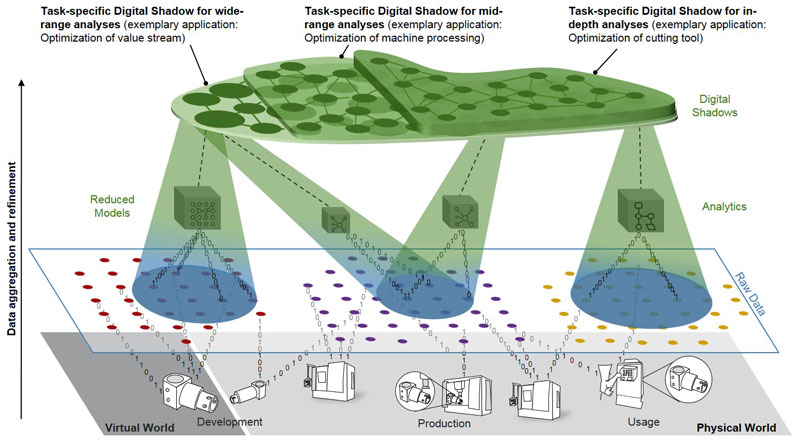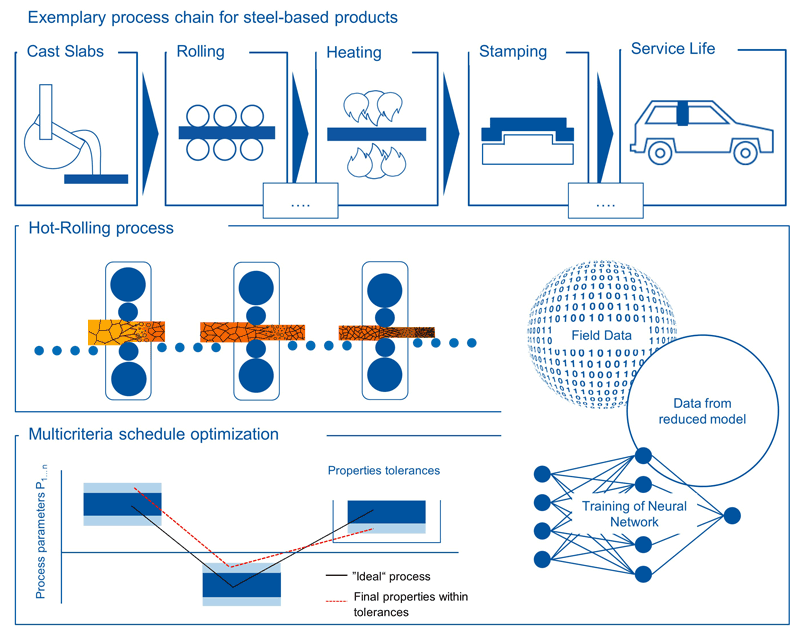by Matthias Jarke (Fraunhofer, FIT and RWTH Aachen), Günther Schuh, Christian Brecher, Matthias Brockmann and Jan-Philipp Prote, (RWTH Aachen and Fraunhofer IPT)
Due to highly sophisticated, specialised models and data in production, digital twins, as defined as full digital representations, are neither computationally feasible nor useful. The complementary concept of digital shadows will provide cross-domain data access in real time by combining reduced engineering models and production data analytics.
Manufacturing is currently at a tipping point induced by digital globalisation. A broad range of converging technologies and concepts based on connectivity and data – from machine learning, to cloud computing, to the Internet of Things – will lead to a massive shift of the manufacturing sector. The vision of our research cluster “Internet of Production” describes the RWTH Aachen University with Fraunhofer’s research roadmap concerning this development. Within an interdisciplinary team originating from the DFG-funded Cluster of Excellence “Integrative Production Technology for High Wage Countries” [1], researchers from engineering, computer science, business and social science are shaping the future of production technology. In addition to the RWTH Laboratory for Machine Tools and Production Engineering WZL and the Fraunhofer Institute for Applied Information Technology FIT, more than 30 institutions are involved in this initiative.
The scientific core concept of the Internet of Production is called “digital shadow”. Extending [2], we distinguish digital shadows from the popular concept of digital twin. The “digital twin” is an active simulation aiming to run in parallel, and interact with, a “real” physical, technical, socio-technical, or business system. In engineering, digital twins are often executions of very rich and powerful, multi-parameter models – in the continuous case complex differential equation systems, in the discrete case, they might represent an entity like a business process model instantiation, for example. The interacting pair of real system and digital twin forms a cyber-physical production system (CPPS).
Digital shadows are abstracted traces captured by sensors of the “real” system, its digital twin, or the interactions between both. The abstractions can be refined physical or empirical models which represent certain aspects of the structure, behaviour, and rationale (goals, obstacles) of CPPS for particular purposes. Digital shadows also provide semantically adequate and context-aware data from production, development and usage in real time with the adequate level of granularity – analogous to proposed travel routes in navigation systems such as TomTom or Google Maps that combine abstracted massive live cell phone data with formal map graphs.
Experience from the Production Cluster spawned our hypothesis that a well-designed collection of digital shadows is more promising for comprehensive production engineering, operation, and management than a full-scale digital twin. Firstly, experience over the past 50 years shows that the growth of production-related data will always outpace our ability to store, communicate, and analyse them. Secondly, digital shadows explicitly address the fact that data and models in producing companies are not just heterogeneous but also usually available only within proprietary systems. This restrains accessibility across engineering domains and organisations. Even with adjacent domains, instant access to data is hardly possible, often leaving engineers with outdated or false information.
An excerpt from an interdisciplinary case study [3] may demonstrate how a digital shadow of production can enable diagnosis, prediction and cross-domain recommendations in domain-specific real-time. Within the lifecycle of steel-based products such as the B pillar in a car (Figure 1), the energy-intensive hot-rolling stage produces sheets with a given height and microstructure through a carefully planned schedule of rolling and cooling steps. Traditionally, finite element simulation (FES) evaluates a manually designed schedule in terms of parameters such as time, energy consumption, and expected result quality. Within the Production Cluster [1], an interdisciplinary team [3] has shown that the FES can be adequately approximated by six reduced analytical models concerning heat transfer (temperature distribution), mechanical load (stress, strain), and microstructure evolution (grain size, recrystallization), reducing the evaluation time from 30-240 minutes by six orders of magnitude to less than 50 milliseconds.

Figure 1: Digital Shadows embedding reduced model in deep learning enable adaptive scheduling in steel production (source: IBF/WZL, RWTH Aachen University).
However, this model-based digital shadow still only concerns a single proposed schedule. It can neither support multi-criteria schedule optimisation nor the ability to dynamically adapt a running schedule when context conditions change, forcing practitioners to avoid required expensive and extremely energy-intensive rework by over-engineering. With the digital shadow approach, the reduced models are embedded in a deep learning neural network that learns near-optimal schedules for desired outputs and given context parameters data-mined from live sensor data. This enables not just real-time adaption and thus more “tolerant” plans, but also creates digital shadows for better synchronisation with later steps in the overall production network. Given that 90% of all steel-based products worldwide undergo hot-rolling, enormous impact on energy consumption and ecological footprint can be expected from just this rather “small” innovation.
Such early experiments in digital shadows for real-time data-driven machine control, process mining, and agile production management make us confident that well-designed digital shadows may significantly increase overall equipment effectiveness (OEE) by offering an abstraction for controlled knowledge sharing (cf. Figure 2): Manufacturers currently only leverage a fraction of the capabilities of their production machinery while vendors of production machinery have detailed knowledge about their machinery, but lack access to the domain experience of their customers. Combining both sides of domain knowledge will lead to increased performance far exceeding that of next-generation hardware.

Figure 2: Linked Digital Shadows improve multi-level overall operational efficiency (OEE) in production (source: WZL, RWTH Aachen University).
Link:
http:// www.production.rwth-aachen.de
References:
[1] C. Brecher, D. Özdemir, eds.: “Integrative Production Technology: Theory and Applications”. Springer, Cham, 2017.
[2] T. Bauernhansl, J. Krüger et int. G. Schuh: “WGP-Standpunktpapier zu Industrie 4.0, 2016
https://kwz.me/hdk
[3] R. Meyes et al.: “Interdisciplinary data-driven production process analysis for the Internet of Production”, Procedia Manufacturing 26: 1065-1076, 2018.
Please contact:
Matthias Jarke, Fraunhofer FIT, Germany,
Matthias Brockmann, Christian Brecher, WZL, RWTH Aachen University, Germany,











